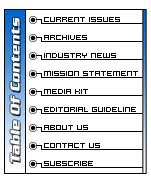|
Disappointed with Editorial
We have known each other a long time. What I have to say is
from me, Carl Reed, GIS professional and not as an official
response from the OGC. I was disappointed when I read your recent
editorial “The Geospatial One-Stop, Two Step”—not because
I am an Open GIS Consortium (OGC) employee but because I am
a GIS professional with 35 years’ experience. Don’t get me wrong,
you are entitled to your opinion. But what is really disappointing
is that you did not properly investigate and get your facts
correct regarding One-Stop before writing the editorial. You
proceed to say that the OGC is competing in the marketplace,
that the OGC is manipulating the marketplace to the detriment
of many GIS vendors, and that interoperability is some esoteric
pursuit. All of these statements could not be further from the
truth.
Rather than argue whether interoperability is a laudable goal,
I would rather focus on the incorrect assertion that the OGC
was competing with a member for doing GeoSpatial One-Stop work
and that there was a “winner.”
Let me begin by stating that “There was NO competition!” There
were two related GOS efforts, but this was by choice of the
GOS Board. Each team was asked to accomplish a specific set
of objectives. Each team was successful in achieving their respective
set of objectives. The details of how particular decisions were
made are available in the GOS Board minutes (www.geo-one-stop.gov/Board/minutes/).
In the summer of 2002, GOS officials, who had worked with us
on previous interoperability projects, approached OGC staff
and discussed the need for a standards-based, interoperable
reference architecture for the GOS portal. As a result
of these discussions, the OGC was selected to manage an open
competition for the portal development, not to do the actual
software development. The RFQ for the interoperability work
was publicly issued by OGC in December 2002 and advertised in
FedBizOpps as required by OMB. The RFQ included specific proposal
evaluation criteria for selection of participants. ESRI and
about 20 others submitted proposals. ESRI competed with other
vendors within a forum provided by OGC; OGC was not competing
with ESRI. Based on the evaluation criteria, a team of companies
was selected to develop the software. ESRI was offered a spot
on that team.
Several months after OGC had initiated work on this project,
the Department of the Interior received an unsolicited proposal
from ESRI to implement an operational portal. This proposal
was discussed at the GOS Board meeting held on February 13,
2003, the minutes of which are a public record (www.geo-one-stop.gov/Board/minutes/21303.html).
Hank Garie, executive director of GOS, communicated that “…current
events have accelerated OMB expectations to have a functional
portal up and running as soon as possible,” and that, “The Administration
has communicated that GOS needs to demonstrate tangible progress
by standing up a functional portal within the next few months.”
These minutes further quote Mr. Garie as stating that, “A functional
version of the portal is possible within the timeframe by applying
a commercial-off-the-shelf (COTS) solution.”
The minutes on this agenda item conclude in the following fashion:
“Summary Recommendations: The Board was requested to support
a decision for two distinct activities: 1) continuation of an
OGC project structured to bench mark interoperability standards
for geospatial portals; 2) Deploy a functional portal for demonstration
of the GOS concept by modifying an existing portal deployed
by the BLM. Motion was made and the resolution passed.” As a
result of this decision, ESRI was tasked to build the entire
portal and the tasking was added to an existing DOI/BLM contract
with ESRI without allowing any other company the opportunity
to bid on this work.
The OGC members created a successful prototype and reference
implementation that we believe to be a valuable community resource.
The reference implementation is also intended to help frame
a formal Request for Proposals (tender) for future operational
portals based on open standards designed to maximize inter-organizational
interoperability. The OGC was never positioned to compete with
its members, many of whom are companies—just like ESRI—that
implement operational systems. Many OGC members, both large
and small companies, were deeply involved in the collaborative
development work that produced the OGC portal prototype and
reference architecture.
So, these are the facts as I know them—primarily extracted from
GOS Board meeting minutes and from other publicly available
documents.
I am not going to discuss the OGC, standards, and interoperability
issues. However, I want to point out that the W3C, OASIS, the
IETF, the ITU, and the Open Group—like the OGC—are all dedicated
to the development of freely available, unencumbered standards
and specifications that enable interoperability and provide
a level playing field for all vendors. If standards-based interoperability
is a pipe dream, then the Internet, the Web, GRID systems, your
car—need I go on—are also all pipe dreams.
The success of the work of the OGC is due to the members who
participate at many levels of effort within the OGC process—whether
writing a specification, commenting on a specification, working
an interoperability initiative, or just listening and learning.
To ensure that anyone can participate, OGC provides a variety
of membership options that are affordable—universities and city
governments can join for $300.00 per year. And your readers
should be aware that ANY organization—member or non-member—can
provide input and comments at any time. Finally, all OpenGIS
Specifications are openly and freely available to anyone, anytime
for download and implementation.
Carl Reed
GIS Professional
Who’s Right?
I just read your editorial on GOS, OGC, and ESRI. Congratulations
on a fine, thought-provoking review of the situation and for
the courage to write it. Amassing the information and cutting
through the crap that has been going on is a major challenge.
Who’s right? Maybe it makes little difference but it appears
that the OGC has seriously damaged their credibility here. But
to be sure, it appears that political expedience at OMB/DOI
was also at play.
Joe Francica, Editor
Directions Magazine
Back
|

